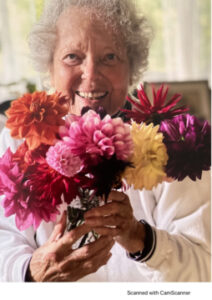
Cornelia Cotton’s house stands on a hill in the Mount Airy section of Croton-On-Hudson, its angular shape a clear tribute to Frank Lloyd Wright.
Its owner, a minor celebrity in these parts, waits for me at the top of the steep staircase. By the time I reach her, we are already discussing Hamlet—its timelessness and relevance, its author’s elusive wife. This is how Cornelia moves through the world: why waste time on small talk when you could discuss the big stuff instead?
Her living room is covered with houseplants, books, and framed photographs. It is a well-loved home full of memories—some Cornelia’s, some other peoples. She wears a fluffy navy sweater, gray pants, and shiny gold sneakers. She is radiant. “So, what would you like to know?” she asks.
Cornelia, now 95, was born in Germany during the Weimar Republic. Her father was a violinist in a symphony orchestra and her mother was a professional modern dancer. She was surrounded by intellectuals and artists, and fortunate to receive a progressive education.
***
But then Hitler came to power. “My family was not exactly welcome during the Hitler years,” she explains. “The Jewish part, and the Swiss part, and the political part… It was all extremely unpleasant, but fortunately the worst did not happen to us.”
Later, Cornelia attended the University of Berlin and, in 1948, became the first German student to be invited to study in America after the war. “It was my dream to go to America,” she says. “As a child, I heard people say that in America people were free, and I wanted to be free.”
After graduating from Georgia State College for Women, Cornelia found a job waiting tables at a summer camp in Connecticut. There she met William Cotton, an artist and woodworking teacher at Walden School in Manhattan. They were soon married and moved into a small apartment in Greenwich Village.
The couple moved up to Croton in 1953. For many years they lived with their three young girls in rental houses while building their home on the weekends and during Bill’s school vacations.
***
Together they mixed concrete, carried heavy beams and rocks, and learned masonry from the skilled stoneworkers in the area. “Some details are still unfinished,” she says, scanning the room. “But that’s okay.”
When her daughters got older, Cornelia asked Bill to teach her photography. “It clicked, so to speak,” she laughs. One of her portraits won a Life Magazine photo contest in 1970. She went on to have a successful career as a portrait artist for roughly 20 years.
Cornelia’s work as a photographer brought her into the folds of Croton’s creative community. When poet Ruth Lisa Schechter put together the first on Croton Council the Arts in 1976, she asked Cornelia to join as a founding member.
Around this same time, a friend offered Cornelia a job at a local art gallery. She enjoyed the work, and eventually partnered with Croton’s Village Historian Jane Northshield to open the Cornelia Cotton Gallery and Old Book Room at 111 Grand Street. After Northshield’s death in 2005, Cornelia’s daughter Amy joined her in the space with a sperate business selling antiques.
Most recently, she has been focused on her own writing. Her first book, Stepping Stones, was published in 2012 and she is at work on her second book now.
“Fortunately, I’ve lived long enough to do all of this,” she says. “I still have some energy left and I’m very grateful for that.”
As I gather my things, we discuss Swann’s Way and the challenges of being an artist today. When I reach the bottom step, she says, “It’s not always easy. Although, for me, everything is joyful. It’s been joyful.”
Caedra Scott-Flaherty is a writer living in Croton-on-Hudson. Find her at Caedra.com.






